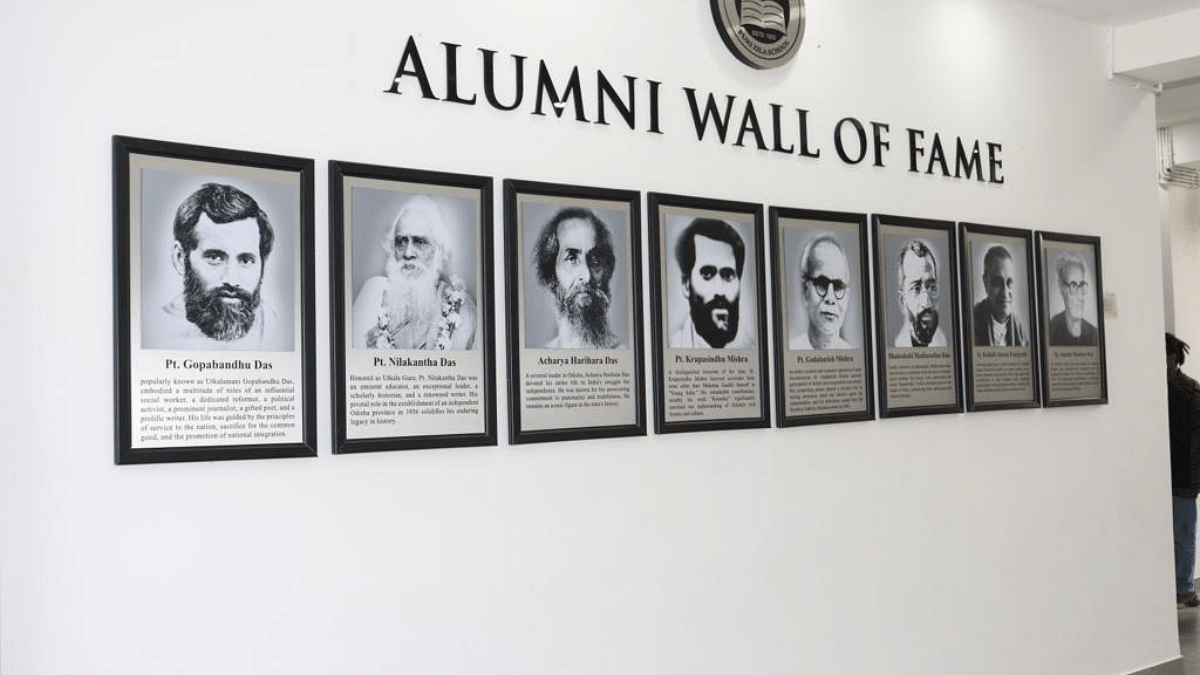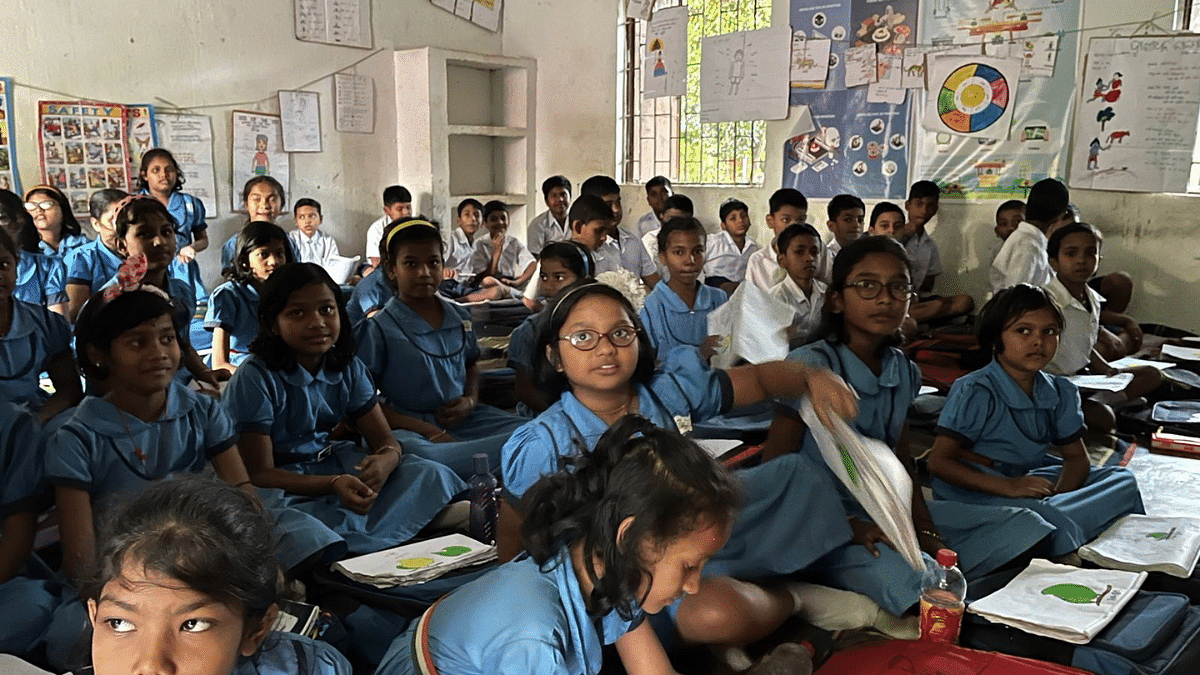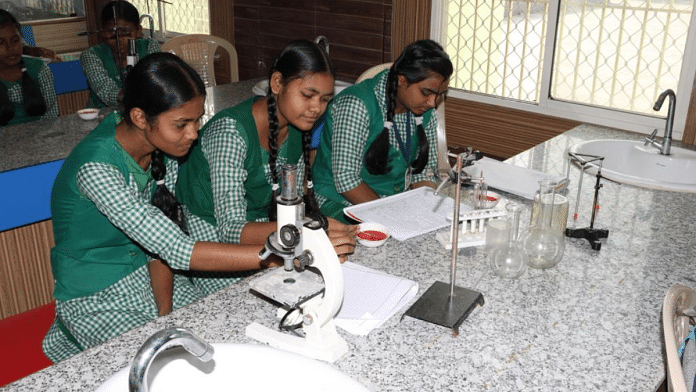Puri/Bhubaneshwar: Two years ago, Sumita Khanda switched from a private school to Odisha government’s Kushabhadra High School in Puri district. Sumita was shocked when she entered the school premises: e-library, smart boards, and science labs greeted her.
The Class 9 student doesn’t miss her old school anymore, a feeling shared by many others like her whose parents decided to opt for government schools.
Learning coding, doing science experiments, reading from the computer and attending smart classes is the new normal for students in government high schools covered under the Odisha government’s 5T High School Transformation Programme.
Focusing on Teamwork, Transparency, Technology, Time, and Transformation, the programme seeks to change the image of higher education in the eastern state. Started in 2020, it has completed three phases in its quest to modernise 8,679 high schools in the eastern state.
The budget for this programme was increased 55 percent from 2018-2019 to 2023-24, according to the government data. A sum of Rs 1,268 crore was allocated for the 5T programme in the 2023-24 budget. Since 2021, the government has noticed a 1.5 percent increase in enrolment for Class 1 to 12.
“Because it is at the cutting edge level, we have just started and we will have to transform all the levels. This has started with transforming the physical infrastructure in high schools,” said Aswathy S, Commissioner-Cum-Secretary of education, Odisha.
Smart class, e-library & much more
When visitors enter the two-storey green building of Puri Zila School, the neat and clean floor with shining tiles catches their eye. The photos of illustrious students including political activist Gopabandhu Das, historian and educator Nilkakantha Das and freedom fighter Acharya Harihar Das adorn one of the walls.

Ayush Satpaty, a Class 10 student, was busy with classmates in a coding session at the school’s e-library. The young minds were trying to make a rocket in a game — Shooter Gamer — through code language.
“Right now, we are learning from YouTube videos, and, sometimes, the teacher helps us. I want to become a bank manager, but you never know…in these times of technology, you will have to do a lot of things,” Ayush said.
The Odisha government has already taken steps to introduce students to Artificial Intelligence (AI) for which it launched the Artificial Intelligence for Youth initiative in May. The initiative is for students below 18 years from 5T schools and Odisha Adarsh Vidyalayas.
“The Odisha government is planning to launch AI in school curriculum from next year as 8,800 high schools are ready with required infrastructure of smartboards, e-libraries, computer and science labs,” Pandian said. “A knowledge team is working on developing a futuristic curriculum for schools and colleges and the government has tied up with organisations like Intel, Nasscom.”
Unlike Puri Zila School, Kushabhadra High School is located in a rural setting near the Kushabhadra river in Puri district. It is in such rural schools that the obstacles to the Odisha government’s ambitious initiative become stark for outsiders.
The school has a water fountain in its lawn in addition to the smart classes, science labs but erratic supply of electricity makes it difficult for students.
In the e-library, there were only two lights and eight computers. Two students were riveted to the computer screen, but electricity kept interrupting the session. A few paces away from the library, students of the 5th standard sat on the floor inside a class with no electricity.

“This is a rural area. So, we face some problems related to electricity, but there is an inverter. It bears the load for some time when electricity is not there,” the library teacher explained.
Acknowledging the problems faced by the higher secondary schools, 5T chairman V.K. Pandian assured that the government is working to mitigate the problems faced by teachers and students.
“We are trying to ensure three connectivity — internet, electricity and physical connectivity (roads). It is a big challenge for us. Eighty percent of the schools did not have electricity when we first started this project,” the former IAS officer said.
“Odisha has 30,000 primary schools. Before we started to work on the high schools, the gap was huge and what you are seeing is much better,” Pandian said. “Special budget will come for primary and elementary schools.”
School and Mass Education secretary Aswathy S. asserted that electricity is provided to 80 percent of the schools in Odisha. “For the rest of it, the power department has been informed (to carry out the work),” he told ThePrint. “The picture of government high schools has to change, physical infrastructure is just beginning.”
Also Read: An Odisha cop is turning low-income Army aspirants’ dreams into reality—free of cost
Alumni community
One of the innovative strategies adopted to supplant government efforts is roping in past students willing to help in developing their schools.
The government is reaching out to school alumni to inspire community action in whatever possible ways — be it donation, sparing time to coach students, organise annual functions, or inviting motivators to inspire students.
Yesteryear students — ranging from businessmen to local leaders and social workers — take out time for the cause as the general feeling in alumni community groups is of helping the young students.
“We conduct meetings once a month to discuss the contribution everyone would want to make. People plant trees or help the school prepare cultural programs,” said Raghunath Lenka, headmaster of Kushabhadra High School.
The school is located in the rural area of Khorda district.
“We try to be connected with school as much as we can. If we are paying Rs 1, the government will pay Rs 2. We get to connect with the young generation and thereby get a chance to do something for the community. We have around 250 people in the alumni group,” said Ravi Sahoo, who passed out from Puri Zila School in 1984.
While Rs 88.83 crore was raised from alumni in 2020-2021, the Odisha government allotted Rs 177.66 crore from its share for the initiative. This share went up to Rs 219.96 crore from alumni and Rs 439.92 crore from the state in 2022-2023, according to the Odisha government.
Long way to go
Back at Puri Zila School, headmistress Jyotimage Mishra is looking forward to bringing more changes.
“We have 18 smart classes which have interaction panels, two science labs, 11 kinds of sports including football, basketball, tennis, judo etc. We are not just giving them the academic knowledge but teaching them the civic sense, cleaning and belongingness,” said the headmistress, whose son studies in the same school.

“Focus is not only on academics. Every student can excel in one discipline and that can be anything from sports to education.”
Unlike the Puri Zila School headmistress, Brahmpur High School headmaster Prakash Chandra Mohanty prefers to wait and watch.
“Government is bringing great facilities to the government schools, but there are no teachers in some schools. In a school where people don’t know how to use mobile phones, how will they teach the students about the computer?” Mohany argued.
Located in Bhadrak district, Brahmpur High School, too, has facilities like the school in Puri.
“Twenty thousand teachers are to be recruited before the election (in Odisha in 2024) but only for government schools, not for government-aided ones. Election duty, census work, mid-day meal distribution…Teachers handle a lot of things,” he explained.
ThePrint was invited by the Odisha government to visit schools in order to see the impact of the 5T High School Transformation Programme
(Edited by Tony Rai)
Also Read: Sanskrit has a Lithuanian sister. Words, phrases, acts of worship



